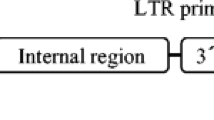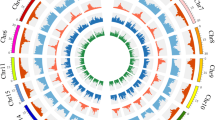Abstract
The most popular retrotransposon-based molecular marker system in use at the present time is the sequence-specific amplification polymorphism (SSAP) system . This system exploits the insertional polymorphism of long terminal repeat (LTR) retrotransposons around the genome. Because the LTR sequence is used to design primers for this method, its successful application requires sequence information from the terminal region of the mobile elements . In this study, two LTR sequences were isolated from the cashew genome and used successfully to develop SSAP marker systems. These were shown to have higher levels of polymorphism than amplified fragment length polymorphic markers for this species.



Similar content being viewed by others
References
Archak S, Gaikwad AB, Gautam D, Rao EV, Swamy KR, Karihaloo JL (2003) Comparative assessment of DNA fingerprinting techniques (RAPD, ISSR and AFLP) for genetic analysis of cashew (Anacardium occidentale L.) accessions of India. Genome 46:362–369
Cardoso JE, Cavalcanti JJV, Cavalcante MJBD, Aragao MLD and Felipe EM (1999) Genetic resistance of dwarf cashew (Anacardium occidentale L.) to anthracnose, black mold, and angular leaf spot. Crop Protect 18:23–27
Casa AM, Brouwer C, Nagel A, Wang L, Zhang Q, Kresovich S, Wessler SR (2000) Inaugural article: the MITE family heartbreaker (Hbr): molecular markers in maize. Proc Natl Acad USA Sci 97:10083–10089
Cavalcanti JJV, Pinto CABP, Crisostomo JR. and Ferreira DF (2000) Diallel analysis to evaluate interpopulational cashew tree hybrids (Portuguese). Pesqui Agropecu Bras 35:1567–1575
Cavalcanti JJV, Crisostomo JR, Barros LM, Paiva JR (2003) Heterosis in precocious dwarf cashew (Portuguese). Cienc Agrotecnol 27:565–570
Ellis TH, Poyser SJ, Knox MR, Vershinin AV, Ambrose MJ (1998) Ty1-copia class retrotransposon insertion site polymorphism for linkage and diversity analysis in pea. Mol Gen Genet 260:9–19
FAOSTAT Agriculture Data (2002) available at http://apps.fao.org
Flavell AJ, Dunbar E, Anderson R, Pearce SR, Hartley R, Kumar A (1992) Ty1-copia group retrotransposons are ubiquitous and heterogeneous in higher plants. Nucleic Acids Res 20:3639–3644
Flavell AJ, Knox MR, Pearce SR, Ellis TH (1998) Retrotransposon-based insertion polymorphisms (RBIP) for high throughput marker analysis. Plant J 16:643–650
Gribbon BM, Pearce SR, Kalendar R, Schulman AH, Paulin L, Jack P, Kumar A, Flavell AJ (1999) Phylogeny and transpositional activity of Ty1-copia group retrotransposons in cereal genomes. Mol Gen Genet 261:883–891
Kalendar R, Grob T, Regina M, Suonemi A, Schulman A (1999) IRAP and REMAP: two new retrotransposon-based DNA fingerprinting techniques. Theor Appl Genet 98:704–771
Konieczny A, Voytas DF, Cummings MP, Ausubel FM (1991) A superfamily of Arabidopsis thaliana retrotransposons. Genetics 127:801–809
Kumar A, Pearce SR, McLean K, Harrison G, Heslop-Harrison JS, Waugh R, Flavell AJ (1997) The Ty1-copia group of retrotransposons in plants: genomic organisation, evolution, and use as molecular markers. Genetica 100:205–217
Nagy ED, Lelley T (2003) Genetic and physical mapping of sequence-specific amplified polymorphic (SSAP) markers on the 1RS chromosome arm of rye in a wheat background. Theor Appl Genet 107:1271–1277
Nambiar MC, Pillai PKT (1985) Cashew. In: Bose TK (ed) Fruits of India: tropical and subtropical. Naya Prokash, Calcutta, pp 409–438
Pearce SR, Harrison G, Li D, Heslop-Harrison J, Kumar A, Flavell AJ (1996a) The Ty1-copia group retrotransposons in Vicia species: copy number, sequence heterogeneity and chromosomal localisation. Mol Gen Genet 250:305–315
Pearce SR, Pich U, Harrison G, Flavell AJ, Heslop-Harrison JS, Schubert I, Kumar A (1996b) The Ty1-copia group retrotransposons of Allium cepa are distributed throughout the chromosomes but are enriched in the terminal heterochromatin. Chromosome Res 4:357–364
Pearce SR, Harrison G, Heslop-Harrison PJ, Flavell AJ, Kumar A (1997) Characterization and genomic organisation of Ty1-copia group retrotransposons in rye (Secale cereale). Genome 40:617–625
Pearce SR, Stuart-Rogers C, Knox MR, Kumar A, Ellis TH, Flavell AJ (1999) Rapid isolation of plant Ty1-copia group retrotransposon LTR sequences for molecular marker studies. Plant J 19:711–717
Porceddu A, Albertini E, Barcaccia G, Marconi G, Bertoli FB, Veronesi F (2002) Development of S-SAP markers based on an LTR-like sequence from Medicago sativa L. Mol Genet Genomics 267:107–114
Purseglove JW (1968) Tropical crops: Dicotyledons. Longman, Harlow
Queen RA, Gribbon BM, James C, Jack P, Flavell AJ (2004) Retrotransposon-based molecular markers for linkage and genetic diversity analysis in wheat. Mol Genet Genomics 271:91–97
Saghai-Maroof MA, Soliman KM, Jorgensen RA, Allard RW (1984) Ribosomal DNA spacer-length polymorphisms in barley: Mendelian inheritance, chromosomal location, and population dynamics. Proc Natl Acad Sci USA 81:8014 –8018
Schulman AH, Flavell AJ, Ellis THN (2004) The application of LTR retrotransposons as genetic markers in plants. In: Miller W, Capy P (eds) Mobile genetic elements: protocols and genomic applications. Humana Press, Totowa, pp 145–173
Suoniemi A, Tanskanen J, Schulman AH (1998) Gypsy-like retrotransposons are widespread in the plant kingdom. Plant J 13:699–705
Virk PS, Pooni HS, Syed NH, Kearsey MJ (1999) Fast and reliable genotype validation using microsatellite markers in Arabidopsis thaliana. Theor Appl Genet 98:462–464
Vos P, Hogers R, Bleeker M, Reijans M, van de Lee T, Hornes M, Frijters A, Pot J, Peleman J, Kuiper M and Zabeau M (1995) AFLP: a new technique for DNA fingerprinting. Nucleic Acids Res 23:4407–4414
Waugh R, McLean K, Flavell AJ, Pearce SR, Kumar A, Thomas BB, Powell W (1997) Genetic distribution of BARE-1-like retrotransposable elements in the barley genome revealed by sequence-specific amplification polymorphisms (S-SAP). Mol Gen Genet 253:687–694
Author information
Authors and Affiliations
Corresponding author
Additional information
Communicated by E. Guiderdoni
N.H. Syed and S. Sureshsundar contributed equally to this investigation.
Rights and permissions
About this article
Cite this article
Syed, N.H., Sureshsundar, S., Wilkinson, M.J. et al. Ty1-copia retrotransposon-based SSAP marker development in cashew (Anacardium occidentale L.). Theor Appl Genet 110, 1195–1202 (2005). https://doi.org/10.1007/s00122-005-1948-1
Received:
Accepted:
Published:
Issue Date:
DOI: https://doi.org/10.1007/s00122-005-1948-1




